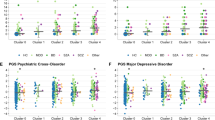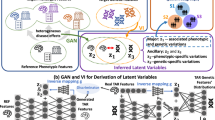Abstract
Subtype Discovery consists in finding interpretable and consistent sub-parts of a dataset, which are also relevant to a certain supervised task. From a mathematical point of view, this can be defined as a clustering task driven by supervised learning in order to uncover subgroups in line with the supervised prediction. In this paper, we propose a general Expectation-Maximization ensemble framework entitled UCSL (Unsupervised Clustering driven by Supervised Learning). Our method is generic, it can integrate any clustering method and can be driven by both binary classification and regression. We propose to construct a non-linear model by merging multiple linear estimators, one per cluster. Each hyperplane is estimated so that it correctly discriminates - or predict - only one cluster. We use SVC or Logistic Regression for classification and SVR for regression. Furthermore, to perform cluster analysis within a more suitable space, we also propose a dimension-reduction algorithm that projects the data onto an orthonormal space relevant to the supervised task. We analyze the robustness and generalization capability of our algorithm using synthetic and experimental datasets. In particular, we validate its ability to identify suitable consistent sub-types by conducting a psychiatric-diseases cluster analysis with known ground-truth labels. The gain of the proposed method over previous state-of-the-art techniques is about +1.9 points in terms of balanced accuracy. Finally, we make codes and examples available in a scikit-learn-compatible Python package. https://github.com/neurospin-projects/2021_rlouiset_ucsl/.
Access this chapter
Tax calculation will be finalised at checkout
Purchases are for personal use only
Similar content being viewed by others
References
Asano, Y.M., Rupprecht, C., Vedaldi, A.: Self-labelling via simultaneous clustering and representation learning. In: ICLR (2020)
Carey, L.A., Perou, C.M., Livasy, C.A., Dressler, L.G., Cowan, D., et al.: Race, breast cancer subtypes, and survival in the Carolina breast cancer study. JAMA 295(21), 2492–2502 (2006)
Caron, M., Bojanowski, P., Joulin, A., Douze, M.: Deep clustering for unsupervised learning of visual features. In: ECCV, pp. 139–156 (2018)
Caron, M., Misra, I., Mairal, J., Goyal, P., Bojanowski, P., Joulin, A.: Unsupervised learning of visual features by contrasting cluster assignments. NeurIPS 33, 9912–9924 (2020)
Chand, G.B., Dwyer, D.B., Erus, G., Sotiras, A., Varol, E., et al.: Two distinct neuroanatomical subtypes of schizophrenia revealed using machine learning. Brain 143(3), 1027–1038 (2020)
Erro, R., Vitale, C., Amboni, M., Picillo, M., et al.: The heterogeneity of early Parkinson’s disease: a cluster analysis on newly diagnosed untreated patients. PLoS One 8(8), e70244 (2013)
Ferreira, D., Verhagen, C., Hernández-Cabrera, J.A., Cavallin, L., et al.: Distinct subtypes of Alzheimer’s disease based on patterns of brain atrophy: longitudinal trajectories and clinical applications. Sci Rep 7, 1–13 (2017)
Honnorat, N., Dong, A., Meisenzahl-Lechner, E., Koutsouleris, N., Davatzikos, C.: Neuroanatomical heterogeneity of schizophrenia revealed by semi-supervised machine learning methods. Schizophr. Res. 214, 43–50 (2019)
Li, J., Zhou, P., Xiong, C., Hoi, S.C.H.: Prototypical contrastive learning of unsupervised representations. In: ICLR (2021)
Lundberg, S.M., Erion, G.G., Lee, S.I.: Consistent individualized feature attribution for tree ensembles. In: ICML workshop (2017)
Lundberg, S.M., Lee, S.I.: A unified approach to interpreting model predictions. In: NeurIps, pp. 4768–4777 (2017)
Maaten, L., Hinton, G.: Visualizing data using t-SNE. J. Mach. Learn. Res. 9(86), 2579–2605 (2008)
Marquand, A.F., Wolfers, T., Mennes, M., Buitelaar, J., Beckmann, C.F.: Beyond lumping and splitting: a review of computational approaches for stratifying psychiatric disorders. Biol. Psychiatry: Cogn. Neurosci. Neuroimaging 1(5), 433–447 (2016)
Marusyk, A., Polyak, K.: Tumor heterogeneity: causes and consequences. Biochim. Biophys. Acta 1805(1), 105–117 (2010)
McInnes, L., Healy, J., Melville, J.: UMAP: Uniform Manifold Approximation and Projection for Dimension Reduction. arXiv:1802.03426 [cs, stat] (2020)
Menyhárt, O., Győrffy, B.: Multi-omics approaches in cancer research with applications in tumor subtyping, prognosis, and diagnosis. Comput. Struct. Biotechnol. J. 19, 949–960 (2021)
Oyelade, J., Isewon, I., Oladipupo, F., Aromolaran, O., Uwoghiren, E., Ameh, F., Achas, M., Adebiyi, E.: Clustering algorithms: their application to gene expression data. Bioinform. Biol. Insights 10, 237–253 (2016)
Planey, C.R., Gevaert, O.: CoINcIDE: a framework for discovery of patient subtypes across multiple datasets. Genome Med. 8(1), 27 (2016)
Radford, A., Metz, L., Chintala, S.: Unsupervised Representation Learning with Deep Convolutional Generative Adversarial Networks. arXiv:1511.06434 [cs] (2016). arXiv: 1511.06434
Rawat, K.S., Malhan, I.V.: A hybrid classification method based on machine learning classifiers to predict performance in educational data mining. In: ICCCN, pp. 677–684 (2019)
Saito, S., Tan, R.T.: Neural clustering: concatenating layers for better projections. In: ICLR - workshop (2017)
Schulz, M.A., Chapman-Rounds, M., Verma, M., Bzdok, D., Georgatzis, K.: Inferring disease subtypes from clusters in explanation space. Sci. R. 10(1), 1–6 (2020)
Sonpatki, P., Shah, N.: Recursive consensus clustering for novel subtype discovery from transcriptome data. Sci. R. 10(1), 1–6 (2020)
Tager-Flusberg, H., Joseph, R.M.: Identifying neurocognitive phenotypes in autism. Philos. Trans. R. Soc. Lond. B Biol. Sci. 358(1430), 303–314 (2003)
Varol, E., Sotiras, A., Davatzikos, C.: HYDRA: revealing heterogeneity of imaging and genetic patterns through a multiple max-margin discriminative analysis framework. Neuroimage 145, 346–364 (2017)
Wang, Y., et al.: Unsupervised machine learning for the discovery of latent disease clusters and patient subgroups using electronic health records. J. Biomed. Inf. 102, 103364 (2020)
Wen, J., Varol, E., Chand, G., Sotiras, A., Davatzikos, C.: MAGIC: multi-scale heterogeneity analysis and clustering for brain diseases. In: MICCAI. LNCS (2020)
Wu, M.Y., Dai, D.Q., Zhang, X.F., Zhu, Y.: Cancer subtype discovery and biomarker identification via a new robust network clustering algorithm. PLOS ONE 8(6), e66256 (2013)
Wåhlstedt, C., Thorell, L.B., Bohlin, G.: Heterogeneity in ADHD: neuropsychological pathways, comorbidity and symptom domains. J. Abnorm. Child Psychol. 37(4), 551–564 (2009)
Yang, B., Fu, X., Sidiropoulos, N.D., Hong, M.: Towards K-means-friendly spaces: simultaneous deep learning and clustering. In: International Conference on Machine Learning, pp. 3861–3870. PMLR (2017)
Yang, T., et al.: Probing the clinical and brain structural boundaries of bipolar and major depressive disorder. Transl. Psychiatry 11(1), 1–8 (2021)
Yang, Z., Wen, J., Davatzikos, C.: Smile-GANs: Semi-supervised clustering via GANs for dissecting brain disease heterogeneity from medical images. arXiv:2006.15255 (2020)
Zabihi, M., Oldehinkel, M., Wolfers, T., Frouin, V., Goyard, D., et al.: Dissecting the heterogeneous cortical anatomy of autism spectrum disorder using normative models. Biol. Psychiatry: Cogn. Neurosci. Neuroimaging 4(6), 567–578 (2019)
Author information
Authors and Affiliations
Corresponding authors
Editor information
Editors and Affiliations
1 Electronic supplementary material
Below is the link to the electronic supplementary material.
Rights and permissions
Copyright information
© 2021 Springer Nature Switzerland AG
About this paper
Cite this paper
Louiset, R., Gori, P., Dufumier, B., Houenou, J., Grigis, A., Duchesnay, E. (2021). UCSL : A Machine Learning Expectation-Maximization Framework for Unsupervised Clustering Driven by Supervised Learning. In: Oliver, N., Pérez-Cruz, F., Kramer, S., Read, J., Lozano, J.A. (eds) Machine Learning and Knowledge Discovery in Databases. Research Track. ECML PKDD 2021. Lecture Notes in Computer Science(), vol 12975. Springer, Cham. https://doi.org/10.1007/978-3-030-86486-6_46
Download citation
DOI: https://doi.org/10.1007/978-3-030-86486-6_46
Published:
Publisher Name: Springer, Cham
Print ISBN: 978-3-030-86485-9
Online ISBN: 978-3-030-86486-6
eBook Packages: Computer ScienceComputer Science (R0)





